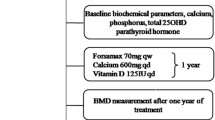Abstract
Breast cancer is the most frequently diagnosed cancer among women in western countries and bone metastases of breast cancer cause significant morbidity. G proteins are important components of a multitude of transmembrane receptors and are involved in the regulation of intracellular signaling pathways such as parathormone receptors 1 and 2 (PTH1 and 2), extracellular calcium-sensing receptor, the calcitonin receptor and the OPG/RANKL-system. A common polymorphism in the gene encoding the G protein β3-subunit, GNB3 825C > T, has been linked to increased G protein activation. To analyse the role of this polymorphism in bone metastasis of breast cancer, we determined GNB3 825C > T genotypes in 500 female breast cancer patients. According to breast cancer staging, patients were divided in three groups, representing patients without metastases (n = 250), those with metastases other than bone (n = 117), and those with bone metastasis (n = 133). Frequency of the GNB3 825 TT genotype was significantly lower among patients with bone metastases (3.1%) than among those with other metastases (12.8%; P = 0.004) or no metastases (13.3%; P < 0.001). In a Cox regression analysis, relative risk of the GNB3 TT genotype for bone metastasis was 0.22 (95% CI 0.08–0.61; P = 0.004) for bone metastasis. We conclude that the homozygous GNB3 825 TT genotype may be protective against development of bone metastasis in breast cancer patients. The precise mechanism for this remains to be determined, but could be due to a direct involvement of G protein-coupled receptors in bone metabolism.

Similar content being viewed by others
References
Greenlee RT, Murray T, Bolden S, Wingo PA (2000) Cancer statistics, 2000. CA Cancer J Clin 50(1):7–33
Ries LAG, Kosary CL, Hankey BF et al (eds) (1999) SEER cancer statistics review, 1973–1996, National Cancer Institute, Bethesda, MD
McPherson K, Steel CM, Dixon JM (2000) ABC of breast cancer epidemiology, risk factors and genetics. BMJ 321:624–628
Kozlow W, Guise TA (2005) Breast cancer metastasis to bone: mechanisms of osteolysis and implications for therapy. J Mammary Gland Biol Neoplasia 10(2):169–180
Clines GA, Guise TA (2005) Hypercalcaemia of malignancy and basic research on mechanisms responsible for osteolytic and osteoblastic metastasis to bone. Endocr Relat Cancer 12(3):549–583
Harrington KD (1997) Orthopedic surgical management of skeletal complications of malignancy. Cancer 80(8 Suppl.):1614–1627
McCudden CR, Hains MD, Kimple RJ et al (2005) G-protein signalling: back to the future. Cell Mol Life Sci 62(5):551–577
Hebert SC (2006) Therapeutic use of calcimimetics. Annu Rev Med 57:349–364
Hoare SR (2005) Mechanisms of peptide and nonpeptide ligand binding to Class B G-protein-coupled receptors. Drug Discov Today 10(6):417–427
Blair JM, Zhou H, Seibel MJ, Dunstan CR (2006) Mechanisms of disease: roles of OPG, RANKL and RANK in the pathophysiology of skeletal metastasis. Nat Clin Pract Oncol 3(1):41–49
Guise TA, Kozlow WM, Heras-Herzig A et al (2005) Molecular mechanisms of breast cancer metastases to bone. Clin Breast Cancer 5(Suppl. 2):S46–53
Bendre M, Gaddy D, Nicholas RW, Suva LJ (2003) Breast cancer metastasis to bone: it is not all about PTHrP. Clin Orthop Relat Res 415(Suppl.):S39–45
Abramow-Newerly M, Roy AA, Nunn C, Chidiac P (2006) RGS proteins have a signalling complex: interactions between RGS proteins and GPCRs, effectors, and auxiliary proteins. Cell Signal 18(5):579–591
Peri S, Navarro JD, Amanchy R et al (2003) Development of human protein reference database as an initial platform for approaching systems biology in humans. Genome Res 13:2363–2371
Siffert W, Rosskopf D, Siffert G et al (1998) Association of a human G-protein beta3 subunit variant with hypertension. Nat Genet 18:45–48
Eisenhardt A, Siffert W, Rosskopf D et al (2005) Association study of the G-protein beta3 subunit C825T polymorphism with disease progression in patients with bladder cancer. World J Urol 3(4):279–286
Sheu SY, Gorges R, Ensinger C et al (2005). Different genotype distribution of the GNB3 C825T polymorphism of the G protein beta3 subunit in adenomas and differentiated thyroid carcinomas of follicular cell origin. J Pathol 207(4):430–435
Ofner D, Zitt M, Menzel H et al (2002) The 825C allele of the gene GNB3 encoding the G-protein-3 subunit is associated with an increased risk for developing colorectal cancer. Eur J Hum Genet 10:105
Nuckel H, Frey U, Aralh N et al (2003) The CC genotype of the C825T polymorphism of the G protein beta3 gene (GNB3) is associated with a high relapse rate in patients with chronic lymphocytic leukaemia. Leuk Lymphoma 44(10):1739–1743
Krippl P, Langsenlehner U, Renner W et al (2004). The 825C > T polymorphism of the G-protein beta-3 subunit gene (GNB3) and breast cancer. Cancer Lett 206(1):59–62
Hortobagyi GN (2005) Moving into the future: treatment of bone metastases and beyond. Cancer Treat Rev 31(Suppl 3):9–18
Author information
Authors and Affiliations
Corresponding author
Rights and permissions
About this article
Cite this article
Clar, H., Langsenlehner, U., Krippl, P. et al. A polymorphism in the G protein β3-subunit gene is associated with bone metastasis risk in breast cancer patients. Breast Cancer Res Treat 111, 449–452 (2008). https://doi.org/10.1007/s10549-007-9808-0
Received:
Accepted:
Published:
Issue Date:
DOI: https://doi.org/10.1007/s10549-007-9808-0




